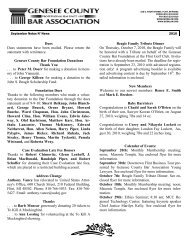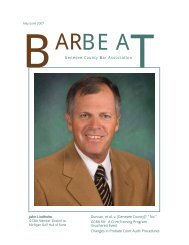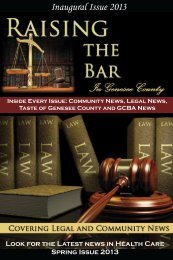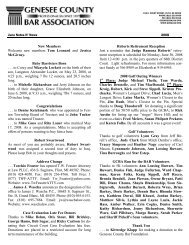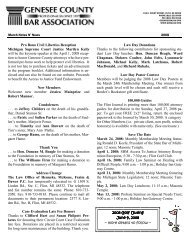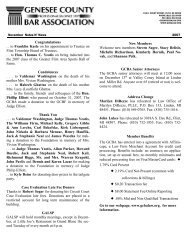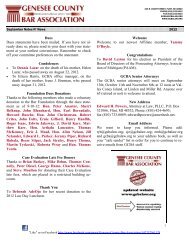July/August, 2004 - Genesee County Bar Association
July/August, 2004 - Genesee County Bar Association
July/August, 2004 - Genesee County Bar Association
You also want an ePaper? Increase the reach of your titles
YUMPU automatically turns print PDFs into web optimized ePapers that Google loves.
12<br />
Copyrights — The State of the Law<br />
by Ernest Gifford<br />
Copyright law has been the most affected<br />
of the intellectual property<br />
disciplines by the technology explosion<br />
of recent years. Problems that could not<br />
have been anticipated by the founding<br />
fathers have fueled the necessity for a<br />
re-examination of the fundamental concepts<br />
of copyright law to accommodate<br />
the new forms of expression provided<br />
by the World Wide Web and digital<br />
technology.<br />
Copyright laws are based upon Article<br />
I, Section 8, Clause 8 of the Constitution,<br />
which gave Congress the power<br />
to act in part “to promote the progress<br />
of science and useful arts, by securing<br />
for a limited time to authors and inventors<br />
the exclusive right to their respective<br />
writings and discoveries.” Congress<br />
acted early to protect “authors” and the<br />
early legislation and cases dealt with the<br />
meaning of “writings” in the Constitution.<br />
Now the term encompasses not<br />
only writings in the strict sense but<br />
other artistic expressions such as paintings<br />
and statues, and more mundane expressions<br />
such as television ads, product<br />
wrappers and pop-up ads on computer<br />
screens.<br />
Until 1976, Congress shared the<br />
power to regulate the protection for<br />
authors with the states. The Copyright Act<br />
of 1976 changed the dual system to provide<br />
almost exclusive federal jurisdiction<br />
and copyrights arise immediately when<br />
the work is completed and fixed in a<br />
tangible medium (17 USC Sec. 301. 302).<br />
In other words, the copyright comes<br />
into being “when the pencil leaves the<br />
paper”. Neither publication with notice<br />
nor registration are prerequisites to<br />
protection.<br />
While registration is no longer necessary<br />
it is nevertheless important. First,<br />
it constitutes clear evidence of what<br />
is protected by the copyright, much<br />
clearer than mailing a copy of the copyrighted<br />
work to one’s self unopened.<br />
It has been demonstrated in patent<br />
infringement cases that envelopes can<br />
be steamed open and the documents<br />
in the envelope replaced with newly<br />
created documents. If registration is not<br />
pursued, the author should have a witness<br />
sign and date the material so that<br />
there will likely be a someone to verify<br />
the authenticity of the material.<br />
More important than proving<br />
creation, however, registration is a<br />
necessary prerequisite to a lawsuit for<br />
infringement (17 USC Sec. 411). Further,<br />
a copyright owner is not entitled to<br />
statutory damages or attorney fees in<br />
cases where the infringement occurred<br />
before registration of the copyright (17<br />
USC Sec 412). To register, an application<br />
form is filed with the U.S. Copyright<br />
Office in the Library of Congress. The<br />
different forms for different classes of<br />
works as well as legal explanations are<br />
available from www.loc.gov. One copy<br />
of the work, if unpublished, or two<br />
copies, if published, with a filing fee of<br />
$30.00 must be included with the application<br />
(17 USC Sec 408).<br />
Where the work is large or three<br />
dimensional such as a sculpture or a doll,<br />
photographs of the work are acceptable.<br />
Where the work is a computer program,<br />
the first 25 and the last 25 pages of the<br />
computer code provide the necessary<br />
copy of the work. This enables the copyright<br />
owner to keep a major portion of<br />
the computer program secret while still<br />
obtaining copyright protection.<br />
The duration of a copyright for an<br />
individual author is the life of the author<br />
plus 70 years. Where the author is an<br />
entity, the copyright is valid for 95 years<br />
from the date of publication or 120<br />
years from the date of creation whichever<br />
occurs first (17 USC Sec 302).<br />
There is an inherent conflict between<br />
freedom of speech and freedom<br />
of the press on the one hand and Congressional<br />
power to provide protection<br />
to “authors” on the other. Both are<br />
derived from the Constitution and both<br />
are therefore deemed to be important<br />
by the Courts. Their interaction has produced<br />
conflicts, which the Courts have<br />
been required to resolve. The judicially<br />
created doctrine of “fair use”, now a<br />
part of the Copyright statute (17 USC<br />
Sec. 107), has been the primary means<br />
for resolving this conflict.<br />
When a news magazine prints a<br />
portion of a copyrighted book and defends<br />
itself in a copyright infringement<br />
action on the theory that it is reporting<br />
news and is therefore protected by freedom<br />
of the press (as Time Magazine did<br />
with President Ford’s memoirs, Harper<br />
& Row v. Nation Enterprises, 105 S. Ct.<br />
2218, 1985), the Courts must decide<br />
whether the magazine’s printing was<br />
“fair use” of the material. The courts will<br />
consider several factors including how<br />
much of the copyrighted material was<br />
used, whether or not the use was for<br />
commercial gain and the effect that such<br />
use will have on the commercial value of<br />
the copyrighted work. In the Harper &<br />
Row case, freedom of the press did not<br />
protect Time Magazine.<br />
Similarly, where a musical artist’s<br />
music is used with new lyrics (as 2<br />
Live Crew did with Roy Orbison’s song<br />
“Pretty Woman”, Campbell v. Cuff-<br />
Rose Music, Inc, 510 U.S. 569 1994),<br />
the Courts must decide whether such<br />
use of a copyrighted song is “fair use”. In<br />
the Orbison case, the Supreme Court<br />
held that 2 Live Crew’s rendition, even<br />
though clearly a commercial use, was<br />
a satire of the copyrighted work and<br />
therefore protected speech and fair<br />
use.<br />
Digital technology has created a<br />
new set of problems for the copyright<br />
<strong>Genesee</strong> <strong>County</strong> <strong>Bar</strong> <strong>Association</strong> BAR BEAT <strong>July</strong> /<strong>August</strong> <strong>2004</strong>



